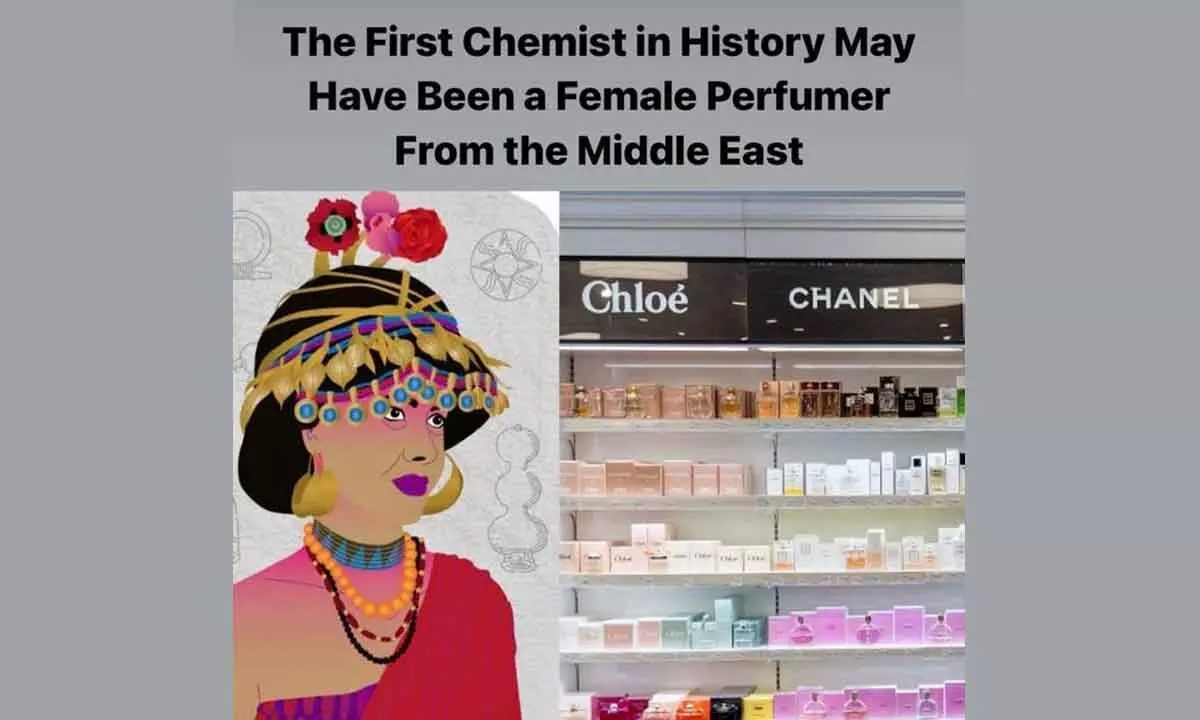Perfumes possess mystical, magical and divine soothing powers
The sensation one gets from the perfume stems from a process where art and chemistry are interlaced
image for illustrative purpose

A new frontier of aroma research lies in the development of the “e-noses”. These are molecule-sensing electronic devices that mimic how our noses detect volatile compounds, providing a “fingerprint”, a screening of the characteristic aroma compounds of a sample
Perfume making dates back at least 3,000 years – to the time of Tapputi-belat-ekalle, who is considered the first chemist in history. What we know about her comes from inscriptions on fragments of clay tablets dating back to the Middle Assyrian period (1400–1000BC).
The inscriptions tell us that Tapputi was in charge of “overseeing the palace” as the leader of a collective of female expert perfume makers in Mesopotamia (present day Iraq and Iran). These muraqqitu, experts in aromatics, prepared fragrances for the king and his royal family. The inscriptions, which are on display in the Vorderasiatisches Museum in Berlin, also show a detailed procedure on how she produced one of her perfumes.
Tapputi and her team used aromatic and medicinal plants and flowers that were commonly found at the time, to extract essential oils and fragrances. Perfumes can be floral, fruity, sweet, spicy, woody and much more. These attributes, or “notes”, are what we are drawn to when picking one to wear. The different chemical molecules that make up the perfume notes are known as volatile compounds. These are compounds that evaporate easily. When these molecules become a gas, they are detected by the sensory organs in your nose. Behind the sensations we get from our favourite perfume, there is a sophisticated process where art and chemistry are tightly interlaced. Tapputi's recipe describes a series of techniques to extract and concentrate volatile scent compounds that are still foundational to several chemistry applications, such as the production of perfumes, cosmetics, medicines or supplements. Some of these extraction techniques involve heating.
To prepare a decoction (the extraction of water-soluble substances from plants), for example, the raw material, such as leaves or roots, is boiled for a prolonged amount of time with a solvent such as water. The technique of infusion was also described. This is where the material to be extracted is soaked briefly in hot water, just like a tea. Other techniques rely on the extractive power of the solvent in which the raw material is soaked for a long time at room temperature – a process known as maceration.
Tapputi's recipe also illustrated a sequence of heating and cooling down of the raw material, in a process that resembles what nowadays we would refer to as distillation. This method uses evaporation and condensation to separate the different volatile scent compounds from each other. This conversion from liquid to a gas state, and vice versa, is based on how easily, and at what temperature, the compounds evaporate. Finally, multiple steps of refinement via filtration were carried out, to obtain perfumes “fit for a king”. These very same techniques are still relevant in modern perfumery but they have been optimised through the centuries and are now more efficient. Are all noses the same? If Tapputi had been born in modern times, she may have been a “nose”, the term for highly skilled fragrance artists, who master chemistry and creativity. Like in nature, many perfumes combine a large number of scent compounds. Making a perfume means assessing the interaction of many volatile compounds in a blend and their stability, individually and together, after bottling. These highly trained professionals can comfortably distinguish between notes with subtle differences and recreate them in their laboratory. The expertise of gifted noses also finds application in sensory analysis in the food, beverages and cosmetics industries, where they study how a product feels through their five senses.
In the laboratory, chemists often rely on advanced instruments to try to understand the origin of the aroma of natural products. These instruments scan through the complex fragrance to separate and identify the hundreds of volatile molecules that, when combined, give the overall scent that our nose can smell.
In our recent study, for example, we screened the aroma of some Irish honey samples, marketed as heather honey, to understand more of its botanical origin. Volatile compounds found in the honey mainly originate from the plants and flowers that the honeybees visited to collect the nectar that, through much processing, is converted into honey. We found all of the samples had aroma notes from several different plants.
A new frontier of aroma research lies in the development of the “e-noses”. These are molecule-sensing electronic devices that mimic how our noses detect volatile compounds, providing a “fingerprint”, a screening of the characteristic aroma compounds of a sample.
These e-noses could be important for other industries too. For example, in the diagnosis of disease (volatile molecule fingerprints may change with blood sugar levels), and for quality control for the food industry, where the volatile fingerprint of a food may change as it spoils.
Modern perfume research is also exploring the important, but often overlooked, psychology of fragrance. They hold highly evocative power over humans. We are starting to understand why certain scents make you fancy a cup of tea, want to keep your nose in a book or feel festive. This seems to depend on the physical interconnection between our sense of smell and the parts of our brain linked to memories and emotions.
This could explain why, in Tapputi's day, the fragrances were not only seen as cosmetics, but they also had a religious function. They were used as part of rituals and ceremonies and offered to the gods to bridge an invisible connection with them.
(The writer is associated with Dublin City University)

